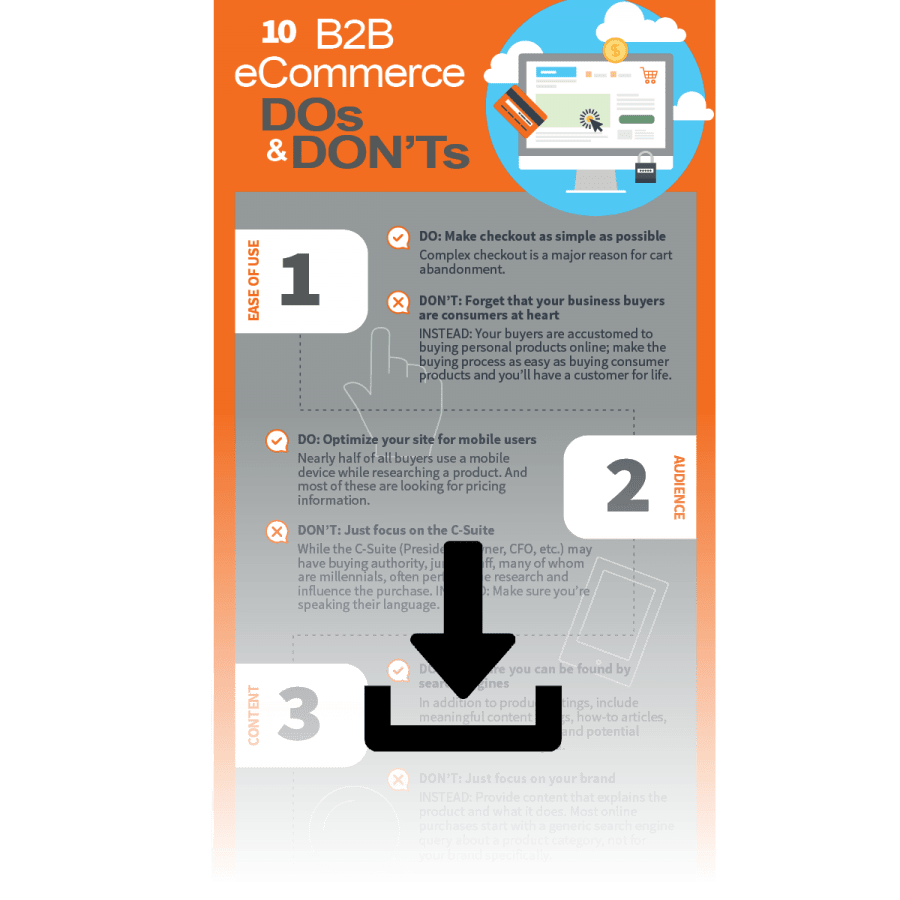
Running a B2B eCommerce operation poses many challenges.
Being online is becoming a necessity for businesses looking to grow. Being able to access customers across the globe, reduce order processing costs, provide customers with an easy order process, and trace past orders can guarantee that your business gains a competitive edge. That’s why having a robust but flexible eCommerce platform is important for streamlining these functions and allowing for room to expand your business in new directions.
With an Acumatica eCommerce software solution, you can manage complex online orders, inventory, picking-packing-shipping, returns, customer support, and accounting from one dashboard. As a true loud system, it’s always available on the device of your choice, Acumatica enables continuity of operations for small and midmarket organizations.
Download the infographic “10 B2B eCommerce Dos and Don’ts” below to learn how you can optimize your online business in today’s digital world.
As B2B companies continue to adopt eCommerce strategies, it’s important to recognize that the world of B2B buying is evolving quickly. In today’s market, business buyers expect a seamless experience similar to what they encounter in their personal online shopping. To ensure your B2B eCommerce site is not only functional but optimized for conversions, follow these key dos and don’ts.
DO: Optimize Your Site for Mobile Users
Nearly half of all buyers use mobile devices to research products, with many specifically searching for pricing information. Ensuring your website is mobile-optimized allows users to easily navigate and find what they need, making it more likely they’ll convert into paying customers.
DON’T: Focus Solely on the C-Suite
While executive-level decision-makers may have the final say, much of the initial research is conducted by junior staff members, many of whom are millennials. Make sure your site and messaging are accessible and engaging for this audience. Speak their language and make your content user-friendly for all levels of decision-makers.
DO: Simplify the Checkout Process
A complicated checkout process is one of the main reasons for cart abandonment. Streamline this process, ensuring it’s intuitive and quick for users to complete their purchases with minimal effort.
DON’T: Forget That Your Business Buyers Are Consumers Too
Just like in the B2C space, B2B buyers are accustomed to seamless purchasing experiences in their personal lives. Make your eCommerce site as easy to navigate as any top consumer platform. If you deliver a smooth experience, you’ll win customers who will return time and time again.
DO: Ensure Search Engines Can Find You
Your eCommerce site needs to be optimized for search engines, not just for product listings, but also with meaningful content like blogs and how-to guides. This helps potential customers find you when they’re conducting product or solution-related searches.
DON’T: Focus Only on Your Brand
While branding is important, B2B buyers often start their search with a product category rather than a brand name. Provide content that highlights the value and functionality of your products to capture more search traffic and guide potential customers to your offerings.
DO: Get Buy-In from Your Sales Team
Your sales team should view your eCommerce platform as an ally, not competition. Explain how automation and self-service options free them from routine tasks, enabling them to focus on building relationships and nurturing leads.
DON’T: Try to Build Everything at Once
Rather than attempting to launch a fully comprehensive site right away, start small. Focus on offering your most popular products and the key functionalities that will make the greatest impact. A simple, effective site is better than an incomplete, complex one.
DO: Prioritize Security
Security is paramount, especially when financial transactions are involved. Make sure your eCommerce platform is secure to build trust with your customers and retain their business.
DON’T: Set It and Forget It
Always be testing. Experiment with different layouts, headlines, and product descriptions to see what resonates best with your audience. A data-driven approach will ensure that your site continues to evolve and improve.
DO: Offer Multiple Payment Options
Many B2B transactions are tied to pre-agreed credit lines or payment terms. Make sure your platform allows customers to use these accounts for easy payment when placing orders online.
DON’T: Assume Customers Know What They Want
Your site should offer intuitive browsing options. Customers expect advanced search features, faceted search, and well-organized content. Make sure your site guides them easily toward the products they need.
DO: Show Personalized Pricing
Make sure customers can see the prices they’ve negotiated when they log into your site. This strengthens your relationships by giving them the transparency they expect.
DON’T: Hide Your Wholesale Prices
If new customers can’t see pricing information, it may deter them from exploring your offerings further. Showcase some of your pricing to give potential customers a glimpse of what they can expect when they engage with you.
DO: Turn Your Website Into a Purchase Management Tool
Help your customers be more efficient by providing them with tools to manage their purchases directly from your site. This gives them more control and builds loyalty.
DON’T: Overlook B2C Strategies
Many successful B2C strategies, like email marketing, social media engagement, and content marketing, apply to B2B as well. Use these tools to build relationships with your customers online and stay ahead of your competitors.
DO: Keep Customers Informed
Regularly update your customers about their orders, shipping status, inventory levels, and any promotions or new products. Providing real-time information enhances their experience and helps them stay competitive.
DON’T: Ignore the Power of Videos
Videos are highly effective in B2B eCommerce. Use product demos, how-to videos, and tutorials to engage your customers and showcase the value of your offerings.
DO: Make Buying Easy
Offer options like in-store or warehouse pickup for online orders. This adds flexibility to the buying process and makes it more convenient for your customers.
DON’T: Forget to Track User Behavior
Leverage tools like Google Analytics to monitor how customers interact with your site. This data can help you measure the effectiveness of your marketing efforts and identify areas for improvement.
By following these dos and don’ts, you can optimize your B2B eCommerce strategy, build stronger customer relationships, and increase conversions. Remember, the key to success is continuously refining your approach to meet the evolving expectations of today’s B2B buyers.



